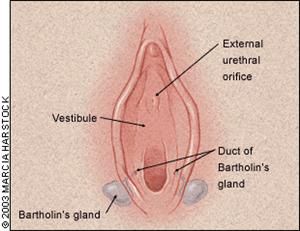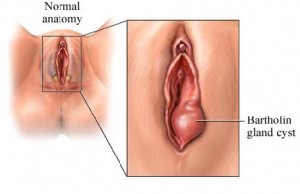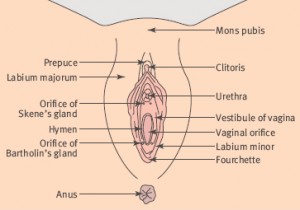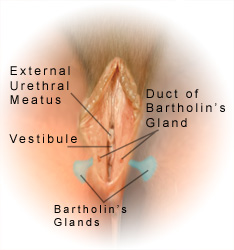Ever heard about the Bartholin Gland? If you are not too familiar with medical terminology, you may be unaware of this very important secretor organ in the body which plays a vital role in sexual intercourse. Read on to know all about the Bartholin Gland.
What is Bartholin Gland?
Page Contents
The Bartholin Gland is one of the two small glands. These are found near the vagina in women. Bartholin Glands are only present in women and they perform a highly important role in sex. The glands are named after Caspar Bartholin the Younger, a late-17th century Danish anatomist. Caspar Bartholin was the first medical professional to form a report on the existence and function of these glands in 1677. The secretor organs are, naturally, named after him.
Bartholin Glands are also known as Bartholin’s Glands or Greater Vestibular Glands.
Bartholin Gland Location

Picture 1 – Bartholin Gland Location
Source – health-writings
Bartholin Glands are located in 4 O’ clock and 8 O’ clock positions in the Labia Minora, or the two inner folds of the vagina. They exist in pairs and are found on either side of the vaginal opening in women. Each Bartholin Gland is about 0.5 cm, or 0.2 inch, in diameter.
Bartholin Gland Purpose
In healthy females, Bartholin Gland functions normally during the time of copulation. These organs secrete mucus which lubricate the vagina. These are prominently functional in women during sexual intercourse. When a woman is sexually aroused, Bartholin Glands secrete 1-2 drops of lubricating fluid into a 1 inch long duct of the vagina known as Bartholin Gland duct or Bartholin duct. This Bartholin Gland discharge makes the Labia Minora slightly moist thus making vaginal penetration in women a more comfortable process.
Bartholin Gland Problems
In abnormal cases, the Bartholin Glands may suffer a blockage. A Bartholin Gland blockage arises if there is a Bartholin Gland infection or Bartholin Gland irritation. An irritation or infection of the Bartholin Gland leads to an obstruction of the vaginal duct. This results in the formation of a Bartholin Gland cyst.
Bartholin Gland Cyst

Picture 2 – Bartholin Gland Cyst
Source – whconnection
A Bartholin Gland cyst is an abnormal lump filled with fluid. It is usually a small pea-sized bump that can grow to be as big as a large marble. It is usually noted as a small bump around the vulva. A redness or swelling around the vulva indicates the presence of a Bartholin Cyst.
Bartholin Gland cysts are usually painless and go away on their own. But an infection in the cyst can produce painful symptoms. Bartholin cysts are normally diagnosed during a common gynaecological exam.
Bartholin Gland Abscess
An infection of the Bartholin Gland cyst can give rise to a Bartholin Gland abscess. The abscess grows larger over a period of 3-4 days. This makes it very difficult for the affected person to walk, sit or perform any other activity that puts pressure on the vulva. An infected Bartholin Gland becomes tender, painful and causes much discomfort in the sufferer. The person also suffers from Bartholin Gland pain during sexual intercourse.
In many infected cases of Bartholin Gland discharge from the vagina can occur. A vaginal discharge is generally more common if the Bartholin Gland infection is caused by a STD (Sexually transmitted Disease) like Gonorrhea or Chlamydia. STD-causing bacteria like Staphylococci and Streptococci can lead to a swelling of the Bartholin Gland. This causes an obstruction of the Bartholin Gland opening. Mucus accumulates inside the gland, thus further irritating the tissue and forming a cyst.
A person having a Bartholin Gland abscess may also suffer from fever. But high body temperatures are not always associated with this condition.
Bartholin Gland Inflammation
In the absence of a Bartholin Gland abscess treatment there may be case of serious Bartholin Gland enlargement. An enlarged Bartholin Gland cyst can push through the labia and form a soft, tangible lump. The cyst becomes tender to touch and causes pain during exercise or other physical activities. The labia may get inflamed and the cyst can burst to release milky white or whitish yellow pus. An untreated infection can result in recurring bacterial infections and labia inflammation.
Swollen Bartholin Gland Treatment
In case of an infectious Bartholin Gland swelling, immediate treatment is necessary. Doctors normally suggest washing the vulva (female genital area) with hot water. Soaking the affected area 3-4 times during a day can help the gland drain on its own.
If this does not help in Bartholin Gland drainage, a Bartholin Gland surgery is needed. The process is fast and can be carried out in the doctor’s office after using local anesthesia. The doctor makes a small surgical cut on the cyst to help drain it completely. A catheter is inserted to help draining while the gland heals. Recovery is usually fast and brings rapid relief to sufferers.
Oral medications for Bartholin gland treatment mainly comprises of antibiotics. Antibiotics are generally unnecessary if the abscess drains properly.
If the gland has suffered a severe damage, a surgeon might suggest carrying out a Bartholin Gland excision. This requires complete removal of the cyst. Bartholin Gland excision recovery is usually fast but depends on how long the operated area takes to heal.
Women suffering from recurring cases of abscesses are often advised to try Bartholin Gland marsupialization. This process involves creating a small, permanent aperture by surgical means to help the gland drain. Large, recurring Bartholin cysts are treated by this procedure. Doctors also suggest carrying out a complete removal of the glands if the patient continues to suffer from repeated Bartholin cyst formation.
Bartholin Gland Mass Prognosis
Recovery is usually complete after treatment. Bartholin abscesses recur only in 10% cases. Bartholin cysts and abscesses normally do not result in any complications. In rare cases of abnormalities in Bartholin Gland tumors of cancerous types are detected. This is mainly seen in women who are over 40 years old.
Pictures of Bartholin Gland
Want to know how Bartholin Gland cysts look like? Check out these Bartholin Gland cyst pictures. Here are also some Bartholin Gland abscess pictures. These Bartholin Gland images will help you know how cysts and abscesses in Bartholin Glands look like. You can also check out the Bartholin Gland diagrams to find out how the glands appear in normal circumstances.

Picture 3 – Bartholin Gland Picture
Source – bmj

Picture 4 – Bartholin Gland Photo
Source – emprocedures
If you have a swollen, painful lump near the vagina, it is necessary that you soak it repeatedly with warm water throughout the day. If it refuses to go away even after 3-4 days, you must get in touch with your doctor. Even though complications are rare, a painful Bartholin Gland mass can be very discomforting for you. Early treatment will help you evade future complications, if any, and let you enjoy life to the fullest.
References:
http://en.wikipedia.org/wiki/Bartholin%27s_gland
http://www.nlm.nih.gov/medlineplus/ency/article/001489.htm
http://emedicine.medscape.com/article/777112-overview
http://www.wisegeek.com/what-is-the-bartholin-gland.htm
http://www.mayoclinic.com/health/bartholin-cyst/DS00667/METHOD=print

Ive had 3bouts w/Bartholin Beast. First in St Criox USVI Dec 2010 4work. ER-Ketamine, sliced, squeezed, packed+medicated. FUP w/GYN 2dys. Didnt make it. BIG fever, back2ER, drained more,repacked. Gyn next day, cyst again. SHE wants2drain! I sd NO! change my ATX I want2fly home n deal w/it. Home end Dec. New atx bactrim DS. great. Fire academy start Jan. But bgn Mar. (3.5wks lto go) much more severe one. Wed. I sucked it up”took it like a man” only girl in the academy, I dared not wuss out4girly issue. ER on Sat. I&D, FUP GYN gave me month of antib. so I cld finish academy. I did, and this past wknd…the WORST YET!!!! HELP!!!! I have no isurance!!
I am 42 yrs old and I can sympathize with you. Ive been suffering for 2 yrs from bartlets cyst and after numerous tubes and balloons they decided to do the marsipulization!! I have been corterized in that area because of the sensitive nerves. I changed doctors and found out that I had a 5cm leasion and it was cancer! So they did a vulvectomy!! I am still in pain!! I stay tender and still have swelling. I am taking 100mg of Amitryptiline and that helps to deal with it. Without the medication, I feel a pinching and pulling. This has consumed me and my life!! Pain that is indescribable!!I am currently looking for a doctor that can help me. Until now I have been without insurance and have relied on the charity facilities here. If anyone knows of a specialist, please let me know. Just know that you are not alone. Theres more of us out here. Its not as common as some people make it out to be. Im so tired and stressed all the time. Im looking for a cure!! I want my life back!